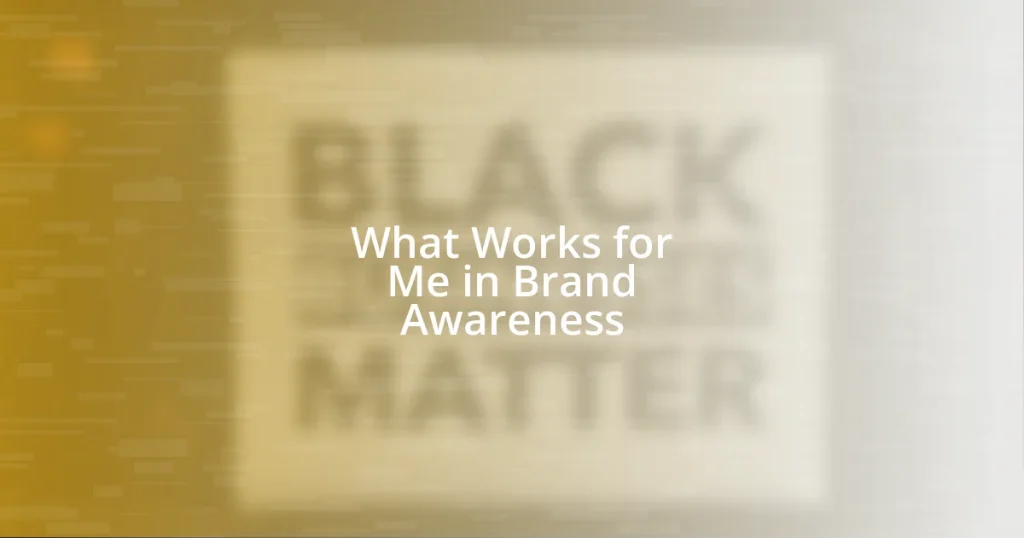Key takeaways:
- Transparency in advertising is essential for building trust and loyalty between brands and consumers, fostering deeper connections and positive brand reputations.
- Effective strategies for implementing transparency include clear communication, encouraging consumer feedback, and showcasing ethical practices prominently in marketing materials.
- The future of advertising transparency will likely leverage innovative technologies like blockchain, focus on narrative-driven content, and emphasize clear communication of data practices to enhance consumer trust.

Understanding transparency in advertising
Understanding transparency in advertising means recognizing the importance of honesty in how products and services are presented. I remember a time when I clicked on an ad for a skincare product, only to discover, after purchasing, that the promised results were exaggerated. Have you ever felt that sense of disappointment? It’s disheartening to realize that the reality doesn’t match the advertisements.
Transparency also involves clarity about sponsorships and partnerships. Influencers often promote brands, but how many of their followers truly know they might be paid for those glowing reviews? I think the lack of this disclosure can create a significant trust gap. When I see a sponsored post, I appreciate it more when the influencer openly shares their connection to the brand, making the relationship clearer.
Moreover, being transparent in advertising builds customer loyalty. I often choose brands that are upfront about their practices, from ingredient sourcing to their environmental impact. When companies share their story and values, it creates a connection; it feels like a conversation rather than a monologue. Isn’t it refreshing to support brands that prioritize honesty?

Importance of honesty in marketing
Honesty in marketing is paramount because it lays the groundwork for trust between brands and consumers. I once chose to buy from a new organic food brand because they were transparent about their sourcing and production processes. I felt good about contributing to a company that truly values authenticity. It’s a simple idea—being open can foster a deeper connection, encouraging customers to return again and again.
Here are some key reasons honesty in marketing matters:
- Builds Trust: Consumers are more likely to support brands that they believe are genuine.
- Fosters Loyalty: Transparent practices often lead to repeat business as customers feel a sense of relationship with the brand.
- Enhances Reputation: A commitment to honesty can help a brand stand out in a crowded market.
- Promotes Customer Education: Open communication allows consumers to make informed decisions based on accurate information.
- Encourages Ethical Standards: Honesty pushes brands to uphold higher ethical standards, benefiting not just consumers but society as a whole.

Benefits of transparent advertising
Transparent advertising offers numerous advantages that resonate deeply with both consumers and brands. For instance, brands that adopt a transparent approach often enjoy an elevated level of consumer trust. I recall a recent encounter with a tech company that openly detailed their data privacy policies in their ads. Reading their commitment felt reassuring—like a warm handshake rather than a cold pitch. It made me more confident in choosing their products over competitors who danced around the issue.
Furthermore, transparent advertising can significantly enhance customer loyalty. When I find brands openly communicating potential drawbacks alongside their product benefits, I feel they genuinely care about my experience. I remember a certain travel service that listed both the perks and potential challenges of their packages. This honesty caught my attention and established a bond, compelling me to choose them for my next vacation. Their straightforward approach made me feel valued as a customer.
Lastly, being transparent also promotes a brand’s positive reputation. Companies known for their honesty can differentiate themselves in a saturated market. I personally gravitate toward brands that don’t shy away from sharing information about their supply chain practices. For example, when I discovered a clothing brand that openly shared details about their ethical production processes, I felt compelled to support them. Their transparency not only informed my purchasing decision but also made me proud to wear their products.
| Benefit | Description |
|---|---|
| Builds Trust | Fosters confidence in consumers through honest communication. |
| Enhances Loyalty | Encourages repeat business by demonstrating care for the customer experience. |
| Promotes Positive Reputation | Differentiates brands in a crowded market by showcasing ethical practices. |

Building consumer trust through transparency
Building consumer trust through transparency is more than just a marketing tactic; it’s a profound commitment to honoring the relationship with customers. I vividly remember a local coffee shop that not only shared the origin of their beans but also introduced their farmers through monthly newsletters. This connection drew me in and built a sense of community, making me feel like part of their journey rather than just a transaction. Isn’t it refreshing when a brand extends a hand and invites you in?
When brands are transparent about their practices, it opens the door for meaningful conversations. Take, for instance, a skincare company that posted genuine before-and-after photos of their products. Their authenticity spoke volumes. It made me question—would I buy from someone who glosses over real results? The trust was palpable, and it compelled many of us to choose them over flashier competitors. This sort of honesty doesn’t merely sell products; it cultivates relationships steeped in integrity.
Additionally, transparency serves as a vital tool for education. I think back to a financial service provider that held weekly webinars to explain their fees and hidden charges. They didn’t have to do this, but their willingness to educate resonated deeply with me and others. Rather than feeling perplexed or misled, we felt empowered. How many brands can truly say they take the time to empower their customers? By being clear and forthright, they transformed uncertainty into confidence, a crucial factor in building lasting trust.

Strategies for implementing transparency
To effectively implement transparency in advertising, brands can start by establishing clear communication channels. I remember a time when a food brand I loved began using social media to share not just their product ingredients but also the sourcing process. It felt like they were pulling back the curtain, allowing me a peek into their world. This openness fostered a connection that made their products feel more trustworthy. Isn’t it reassuring when you know what you’re consuming?
Another viable strategy is to encourage consumer feedback and showcase it publicly. I once engaged with a fitness app that actively sought user reviews. They would share both the rave and the not-so-great feedback on their platform. This candid approach was refreshing; it made me feel valued as a user, knowing my opinion mattered. How often do we see brands willing to show both sides of the coin? That willingness not only validates customer experiences but also builds a community around authenticity.
Finally, integrating transparency into marketing materials can do wonders for a brand’s credibility. I can think of a clothing retailer that prominently displayed their fair wage policy right on their website. It wasn’t just a tiny footnote; it was a proud banner statement. This clear message about their ethical practices spoke volumes to me. It’s incredibly motivating to support brands that walk the talk, don’t you think? Communicating values like these not only attracts consumers but also fosters long-term loyalty.

Measuring the impact of transparency
Measuring the impact of transparency in advertising requires looking at how consumer perceptions shift over time. I recall my experience with a travel company that began openly posting reviews, good and bad, about their packages. Initially, I was skeptical—did they really want us to see the negative feedback? But over time, their honesty convinced me to trust them more. It’s amazing how transparency can transform initial doubts into loyalty.
Another fascinating way to gauge transparency’s effectiveness is through engagement metrics. I’ve noticed that brands sharing behind-the-scenes content often see higher interaction rates on social media. For instance, a local bakery I follow started posting videos of their daily bread-making process. Watching the care they put into their craft made me consistently stop by their store. Could this shift in connection be the reason for their increasing sales? I sure think so.
Lastly, customer surveys can provide valuable insights into how transparency influences buying decisions. I remember participating in a survey from an online clothing retailer, where they asked specific questions about their transparency practices. The results showed that consumers like me appreciated brands sharing information about their supply chains. Knowing where my clothes come from creates a bond; it feels like I’m participating in making ethical purchases. Isn’t it empowering to see brands respond to our desire for honesty?

Future trends in advertising transparency
The future of advertising transparency is poised to embrace innovative technologies. I remember attending a seminar where the concept of blockchain for tracking ad spend was introduced. It blew my mind! Imagine being able to see exactly where every dollar goes and how it contributes to the message you’re receiving. This level of detail could dramatically shift how we view and trust advertising.
As consumers become more savvy about the information presented to them, I foresee brands needing to adopt a more narrative-driven approach. A few months ago, I stumbled upon a brand that shared video stories of their employees and their experiences. These personal testimonials were compelling and heartfelt, revealing the human side of the company. Have you ever felt more connected to a brand after seeing the individuals behind it? That connection could become essential in an era where authenticity reigns supreme.
Moreover, I believe the rise of personalized marketing will push brands to be clearer and more transparent about their data practices. I had a conversation with a friend who felt uneasy about how brands used data to target ads. It struck me that if companies openly communicated how they collected and used personal information, they could build greater trust with consumers. Wouldn’t it be reassuring to know exactly what data is being shared and why? This transparency could pave the way for a healthier relationship between brands and consumers in the future.















